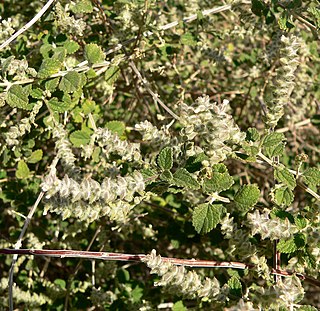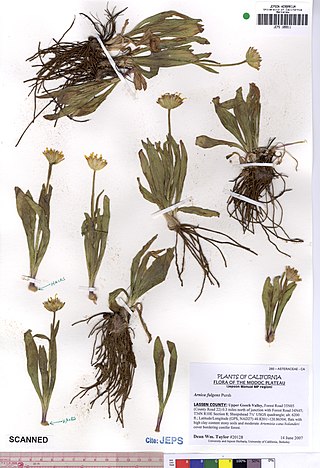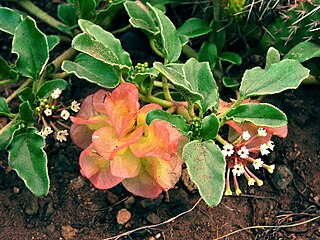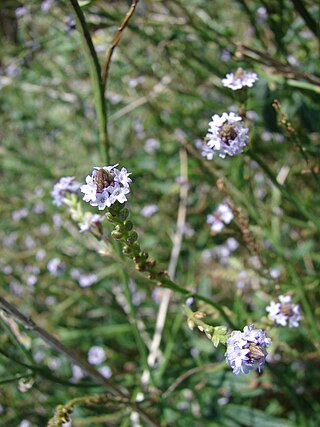
Abronia umbellata is a flowering annual plant which is native to western North America. Other common names include beach sand verbena and purple sand verbena.

Epilobium densiflorum is a species of willowherb known by the common names denseflower willowherb, dense spike-primrose or dense boisduvalia. It is native to western North America from British Columbia to Baja California, where it is found in a variety of habitats. This is an erect annual often exceeding a meter in height with fuzzy green foliage. The pointed leaves are up to 8 centimeters long near the base of the plant, and the upper leaves are generally more hairy than the lower. The stem may branch or not. The top of the stem is occupied by a hairy, leafy, densely flowered inflorescence. Each flower has four deeply notched petals in shades of pinkish purple to nearly white with dark veining, each about a centimeter long. The fruit is a cylindrical capsule about a centimeter long.

Abronia turbinata is a species of flowering plant in the four o'clock family known by the common name transmontane sand-verbena. It is native to eastern California and Oregon and western Nevada, where it grows in desert and plateau scrub.

Boechera sparsiflora is a species of rockcress known by the common names sicklepod rockcress and elegant rockcress. It is native to western North America from California to Utah to Yukon, where it can be found in a number of habitats. This is a coarsely hairy perennial herb growing one or more thick stems from a caudex. The stem may branch or not and it reaches up to 90 centimeters in maximum height. The leaves vary in shape from linear to arrowhead-like and may or may not have toothed edges. They are usually hairy and up to 8 or 10 centimeters long. The raceme inflorescence bears a number of flowers with spoon-shaped petals about a centimeter long in shades of purple or pink. The fruit is a large, curved silique 6 to 12 centimeters long.

Aloysia wrightii is a species of flowering plant in the verbena family known by the common names Wright's beebrush and oreganillo. It is native to the Sonoran Desert of southwestern United States and northern Mexico, where it can be found in moist desert canyons, scrub, and woodland habitat. This is a thickly branching shrub which reaches nearly two meters in maximum height and is generally rounded in form. It has small, oval-shaped to nearly round leaves each no more than two centimeters long. The leaves have lightly toothed edges and hairy undersides. The inflorescence is a narrow, woolly spike up to 6 centimeters long, with small, widely spaced white flowers. It is a valuable nectar source for native solitary bees. It is also larval and adult food plant for the rustic sphinx moth (Manduca rustica).

Androsace occidentalis is a species of flowering plant in the primrose family known by the common name western rockjasmine.

Arnica fulgens is a species of arnica known by the common names foothill arnica and hillside arnica. It is native to western North America, from British Columbia east to Saskatchewan and south as far as Inyo County, California, and McKinley County, New Mexico. It grows in open, grassy areas.
Calycadenia spicata is a species of flowering plant in the family Asteraceae known by the common name spiked western rosinweed. It is endemic to central California, where is a common grassland plant in the Central Valley and adjacent Sierra Nevada foothills from Butte County to Kern County.

Potentilla flabellifolia is a species of cinquefoil known by the common names high mountain cinquefoil, fanleaf cinquefoil and fan-foil.
Ribes binominatum is a species of currant known by the common names trailing gooseberry and ground gooseberry.

Trifolium microcephalum is a species of clover known by the common names smallhead clover and small-headed clover.
Tripterocalyx crux-maltae is a species of flowering plant in the four o'clock family known by the common names Lassen sandverbena and Kellogg's sand-verbena.

Tripterocalyx micranthus is a species of flowering plant in the four o'clock family known by the common names smallflower sandverbena and small-flowered sand-verbena.

Verbena bracteata is a species of verbena known by the common names bracted vervain, bigbract verbena, prostrate vervain, and carpet vervain. It is native to North America where it is widespread, occurring throughout the continent except for northern Canada and southern Mexico. It occurs in many types of habitat, especially disturbed areas. It typically blooms between the months of May and October. This annual or biennial herb produces several hairy, spreading stems up to 30 centimeters long forming a low mat on the ground. The hairy leaves are toothed or lobed. The inflorescence is a spike of flowers which is dense with long, pointed, leaflike bracts each up to 8 millimeters long. Each small tubular flower is about half a centimeter wide and white to pale purple in color.

Glandularia gooddingii is a species of flowering plant in the verbena family known by the common name southwestern mock vervain. It is native to the southwestern United States and northern Mexico, where it occurs in sandy and rocky desert habitat. It is a perennial herb producing several hairy, decumbent to erect stems up to 45 centimeters long. The hairy leaves are generally divided at the base into a few lobes, which are edged with large teeth or small lobes. The plant blooms in large, dense, head-like spikes of many flowers. Each flower has a calyx of hairy sepals and a pale purple-blue corolla up to 1.4 centimeters long.

Verbena litoralis is a species of verbena known by the common names seashore vervain and Brazilian vervain, and in Hawaiian, ōwī. It is native to the Americas from Mexico south through Central and South America to Argentina and Chile. It is present throughout the world as an introduced species and in some areas a noxious weed. It is naturalized in the contiguous United States, Puerto Rico, Hawaii, Italy, Spain, South Africa, Mauritius, the Galápagos Islands, Australia, Easter Island, French Polynesia, Japan, New Zealand, and other places. It grows in many types of habitat, including disturbed and cultivated areas.
Verbena menthifolia is a species of verbena known by the common name mint-leaved vervain or mint vervain. It is native to the southwestern United States and northern Mexico, where it occurs in many types of open, dry habitat such as desert scrub. This perennial herb produces one or more rough-haired, erect stems up to about 75 centimeters in maximum height. The hairy leaves are a few centimeters long and are divided near the base into a few narrow lobes which have serrated edges. The inflorescence is made up of one to three narrow, erect spikes of flowers up to 30 centimeters long. The flowers are spaced, not densely packed on the slender spike. Each flower has a small purple corolla 2 or 3 millimeters wide.

Glandularia pulchella is a species of flowering plant in the verbena family known by the common name South American mock vervain. It is native to Brazil, Argentina, and Uruguay, and it is present elsewhere as an introduced species and roadside weed. It is an annual or perennial herb producing one or more stems growing decumbent to erect in form and hairy to hairless in texture. The rough-haired leaves are divided deeply into lobes. The inflorescence is a dense, headlike spike of many flowers up to 1.5 centimeters wide. Each flower corolla is up to 1.4 centimeters wide and white to purple in color.

Veronica cusickii is a species of flowering plant in the plantain family known by the common name Cusick's speedwell. It is native to western North America from British Columbia to Montana to northern California, where it occurs in mountain meadows and forests.

Abronia macrocarpa is a rare species of flowering plant known by the common name largefruit sand verbena. It is endemic to eastern Texas, where its current range is limited to Freestone, Leon, and Robertson counties. It inhabits harsh, open sand dunes on savannas, growing in deep, poor soils. It was first collected in 1968 and described as a new species in 1972. It is a federally listed endangered species of the United States.
















